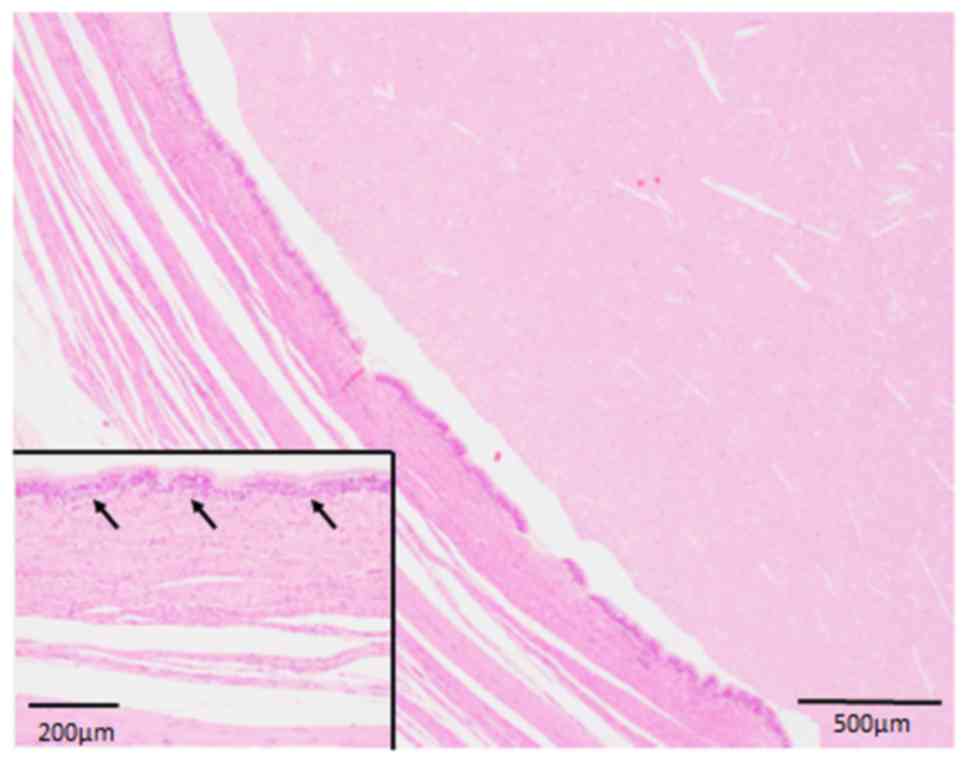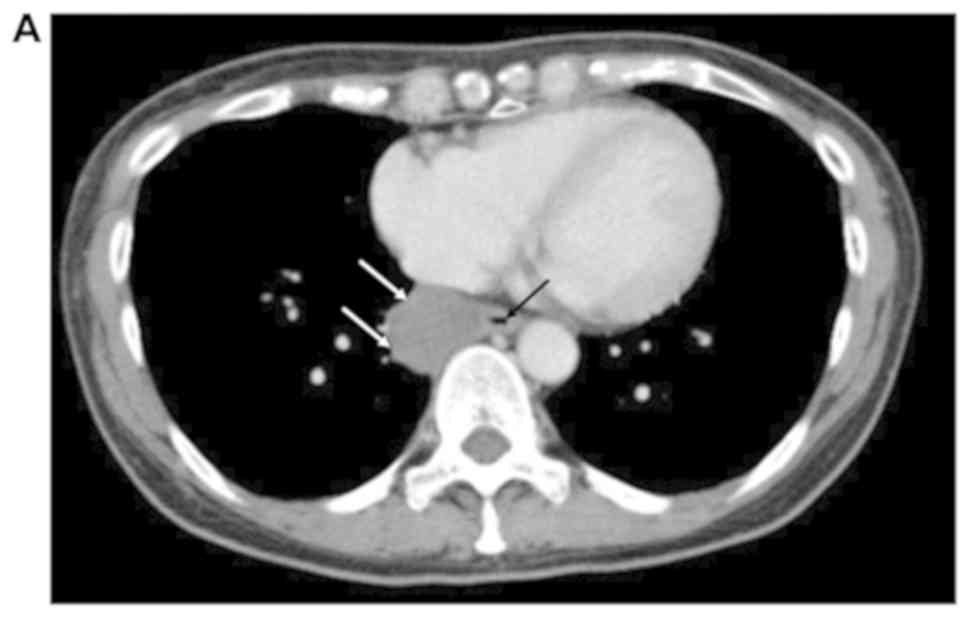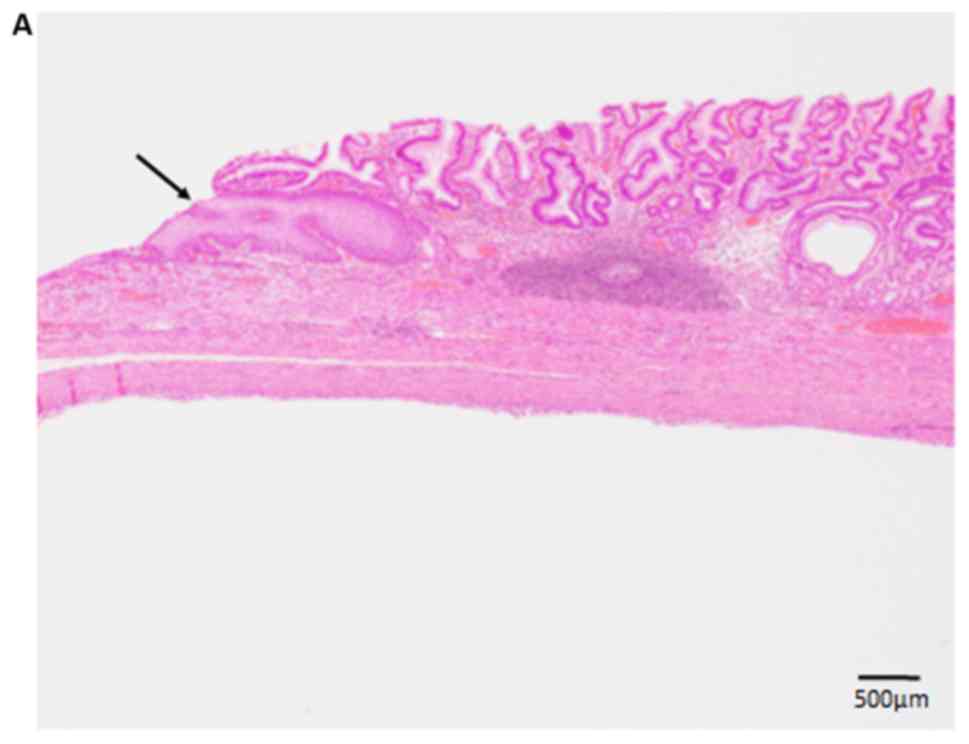Intramural bronchogenic cysts of the esophagus and gastroesophageal junction: A case report
- Authors:
- Published online on: June 3, 2020 https://doi.org/10.3892/mco.2020.2058
- Pages: 162-168
-
Copyright: © Matsuda et al. This is an open access article distributed under the terms of Creative Commons Attribution License.
Abstract
Introduction
Bronchogenic cyst is a relatively rare congenital malformation that develops from abnormal budding of the ventral foregut during the early stage of gestation (1). Histologically, the cyst wall is covered by respiratory-type ciliated epithelium that may include cartilage and bronchial glands (2). The location of the cyst is dependent on the stage of embryogenesis at which budding of the foregut occurs (1). The most common location of bronchogenic cysts is the middle and superior mediastinum, following the lung parenchyma (1,2). Unusual locations of bronchogenic cysts include the thymus, pericardium, diaphragm, esophagus, stomach, and retroperitoneum (3-10).
Intramural esophageal bronchogenic cysts are rare, and only 25 cases have been reported in the English literature since 2000 (7,8,11-25). However, some cases of bronchogenic cysts in the mediastinum perforating into the esophagus have been described (26). Intramural bronchogenic cysts in the gastroesophageal junction are extremely rare (only 6 cases have been reported in the English literature) (27-32), and because of the rarity of intramural bronchogenic cysts in the esophagus and gastroesophageal junction, their unique clinicopathological features have not been well recognized. The treatment strategy for bronchogenic cyst is complete excision to avoid recurrence and rare malignant transformation (33,34). Therefore, accurate pre-operative diagnosis is very important for treatment.
In this study, we report three new cases of intramural bronchogenic cysts in the esophagus and gastroesophageal junction and review the clinicopathological characteristics of these rare lesions.
Case report
Case 1
A 35-year-old Japanese man presented with dysphagia. Upper endoscopic examination revealed an esophageal submucosal tumor. Pre-operative computed tomography (CT) was not available in our hospital. Subsequently, thoracoscopic enucleation of the tumor was performed. Histopathological examination indicated that a cyst (4.5x4x3.5 cm in diameter) was located in the muscularis propria and contained exudative fluid (Fig. 1). The cyst wall was covered by respiratory type ciliated epithelium without atypia (Fig. 1 inset). Neither cartilage nor bronchial glands were observed in the cyst wall. On the basis of these results, the patient was diagnosed with an intramural esophageal bronchogenic cyst. The post-operative course was uneventful, and the cyst did not reoccur by CT over 3 years of medical follow-up.
Case 2
A 50-year-old Japanese woman presented with pharyngeal pain and dysphagia. Upper endoscopic examination revealed a submucosal tumor in the esophagus, and no surface mucosal abnormality was noted. CT demonstrated a submucosal tumor in the esophagus (Fig. 2A). Subsequent endoscopic examination showed that the submucosal tumor was perforating into the esophageal lumen. Therefore, she underwent thoracoscopic subtotal esophagectomy. Histopathological examination revealed that the cyst (3.5x2 cm in diameter) was located in the muscularis propria of the esophagus, and perforated into the surface squamous mucosa of the esophagus, accompanied by lymphoplasmacytic infiltration around the cyst (Fig. 2B). The cyst wall was covered by respiratory-type ciliated epithelium without atypia, and a few goblet cells were occasionally observed (Fig. 2B, inset). Neither cartilage nor bronchial glands were observed in the cyst wall. On the basis of these clinical findings, the patient was diagnosed with an intramural bronchogenic cyst perforating into the esophageal. The post-operative course was uneventful, and the patient was free from recurrence by CT during the 3 months of medical follow-up.
Case 3
A 34-year-old Japanese man presented with heartburn. Upper endoscopic examination demonstrated that a submucosal tumor (4.5x3.3 cm in diameter) was located immediately under the gastroesophageal junction without a remarkable change on the surface of the gastric mucosa. Pre-operative computed tomography (CT) was not available in our hospital. Subsequently, enucleation of the tumor was performed. Histopathological analysis showed that a large cyst was present under the mucosa of the gastroesophageal junction (Fig. 3A and B) and its wall was covered by respiratory-type ciliated epithelium without atypia (Fig. 3B, inset). Neither cartilage nor bronchial glands were observed in the cyst wall. Accordingly, the patient was diagnosed as intramural bronchogenic cyst in the gastroesophageal junction. The post-operative course was uneventful, and the patient was free from recurrence by CT for 1 year of medical follow-up.
Discussion
In this article, we describe the clinicopathological features of three cases of intramural bronchogenic cysts in the esophagus and gastroesophageal junction. Table I summarizes the clinicopathological features of intramural bronchogenic cysts of the esophagus and gastroesophageal junction that have been reported since 2000.
Table IClinicopathological features of intramural bronchogenic cysts occurring in the esophagus and gastroesophageal junction. |
Among the 34 patients, men and women were equally affected. The median age of the patients was 34.5 years with a wide age distribution (from 3 days to 71 years) (Table I). The most common chief complaint was dysphagia with discomfort and pain, and no specific complaint for this lesion is present (Tables I and II). These symptoms may appear only when the cysts become larger, leading to compression of the esophagus and gastrointestinal junction. As most patients have small asymptomatic cysts (7), the accurate morbidity of these lesions is unclear. Histopathologically, the respiratory-type ciliated epithelium was observed in all cases, and cartilage and bronchial glands were occasionally found in the cyst wall.
Accurate pre-operative diagnosis of bronchogenic cyst is very important for its appropriate treatment. The diagnosis of these lesions is challenging because they do not have specific imaging characteristics. Ko et al (22) reported the imaging characteristics of 7 cases of esophageal bronchogenic cysts. In the report, computed tomography (CT) revealed that well-defined thin-wall cystic lesions were present within the esophageal wall. Furthermore, varied cyst densities were observed (because of the content of the cyst) without enhancement after administration of a contrast agent, and no intracystic solid content or abnormal air was identified (22). However, it may be difficult to distinguish intramural bronchogenic cysts from mediastinal masses, including lymphadenopathy or mediastinal tumors, compressed against the esophageal wall (7,22). Furthermore, magnetic resonance imaging (MRI) showed variable signal intensities on T1-weighted images and a homogenous, high signal intensity on T2-weighted images (25).
Recently, endoscopic ultrasound (EUS) examination has been recognized as a useful tool for the diagnosis of bronchogenic cysts (7). EUS can identify whether the lesions of the esophagus and gastroesophageal junction are cystic or solid. Moreover, fine-needle aspiration (FNA) cytological examination using EUS can provide an even more accurate diagnosis because by this method it is possible to obtain a sample from the cyst wall. However, EUS-FNA may not be recommended for all patients with bronchogenic cysts because it can induce an infection, which would complicate the operation (7). The treatment strategy for bronchogenic cysts in the esophagus and gastroesophageal junction is complete resection (7). Therefore, a combination of the above-mentioned imaging techniques is required for an accurate pre-operative diagnosis of bronchogenic cyst.
The interesting finding of the present study is that one of bronchogenic cysts perforated into the esophageal lumen (Case 2). Only the second endoscopic examination detected the connection between the cyst and the surface mucosa of the esophagus. Therefore, secondary inflammation (probably due to infection) may have led to perforation of the cyst into the esophageal surface mucosa. Previous studies have already described an esophageal bronchogenic cyst with a connection to the surface squamous mucosa (17) and a mediastinal bronchogenic cyst perforated into the esophageal wall (26).
In conclusion, we reviewed the clinicopathological features of bronchogenic cysts in the esophagus and gastroesophageal junction. No specific symptoms or pre-operative imaging characteristics were present in this lesion, therefore, bronchogenic cyst must be added a list of differential diagnosis of the submucosal tumor of the esophagus and gastroesophageal junction. As surgical resection is recommended for this lesion, recognition of the clinicopathological features of bronchogenic cysts is important for accurate pre-operative diagnosis of this lesion.
Acknowledgements
Not applicable.
Funding
No funding was received.
Availability of data and materials
All data generated or analyzed during this study are included in this published article.
Authors' contributions
HM, MI and CM conceived and designed the present study. HM, MI, CM, TM, KI, MS and KT collected and analyzed data. HM and MI drafted the manuscript and figures. All authors read and approved the final manuscript.
Ethics approval and consent to participate
The present study was conducted in accordance with the Declaration of Helsinki, and the study protocol was approved by the Institutional Review Board of Kansai Medical University Hospital (approval no. 2019050). Opt-out consent was obtained from each participant of this study.
Patient consent for publication
The need for informed consent was waived due to the retrospective design of the study, and opt-out consent was obtained from each participant of the present study.
Competing interests
The authors declare that they have no competing interests.
References
|
Berrocal T, Madrid C, Novo S, Gutiérrez J, Arjonilla A and Gómez-León N: Congenital anomalies of the tracheobronchial tree, lung, and mediastinum: Embryology, radiology, and pathology. Radiographics. 24(e17)2004.PubMed/NCBI View Article : Google Scholar | |
|
Limaïem F, Ayadi-Kaddour A, Djilani H, Kilani T and El Mezni F: Pulmonary and mediastinal bronchogenic cysts: A clinicopathologic study of 33 cases. Lung. 186:55–61. 2008.PubMed/NCBI View Article : Google Scholar | |
|
Hamouri S, Hatamleh M, Alaydi J, Alhadidi H, Alomari M, Aldaoud N and Darayseh B: Intra-thymic bronchogenic cyst an extremely rare tumor of anterior mediastinum in adults. J Cardiothorac Surg. 13(120)2018.PubMed/NCBI View Article : Google Scholar | |
|
Grozavu C, Fera A, Iliaş M and Pantile D: Intrapericardial development of a bronchogenic cyst-case report. Chirurgia (Bucur). 111:345–349. 2016.PubMed/NCBI | |
|
Simonetti S, Canalís E, Macías L and Carrasco MA: Clinico-pathological features of the intradiaphragmatic bronchogenic cysts: Report of a case and review of the literature. Pathologica. 110:116–120. 2018.PubMed/NCBI | |
|
Itoh H, Shitamura T, Kataoka H, Ide H, Akiyama Y, Hamasuna R, Hasui Y, Osada Y and Koono M: Retroperitoneal bronchogenic cyst: Report of a case and literature review. Pathol Int. 49:152–155. 1999.PubMed/NCBI View Article : Google Scholar | |
|
Cheng Y, Chen D, Shi L, Yang W, Sang Y, Duan S and Chen Y: Surgical treatment of an esophageal bronchogenic cyst with massive upper digestive tract hematoma without esophagectomy: A case report and the review of the literature. Ther Clin Risk Manag. 14:699–707. 2018.PubMed/NCBI View Article : Google Scholar | |
|
Altieri MS, Zheng R, Pryor AD, Heimann A, Ahn S and Telem DA: Esophageal bronchogenic cyst and review of the literature. Surg Endosc. 29:3010–3015. 2015.PubMed/NCBI View Article : Google Scholar | |
|
Chhaidar A, Ammar H, Abdessayed N, Azzaza M, Gupta R, Abdennaceur N, Bdioui A, Mokni M and Ali AB: Large bronchogenic cyst of stomach: A case report. Int J Surg Case Rep. 34:126–129. 2017.PubMed/NCBI View Article : Google Scholar | |
|
Tu C, Zhu J, Shao C, Mao W, Zhou X, Lin Q, Li Z, Zhang J, Zhou Q and Chen W: Gastric bronchogenic cysts: A case report and literature review. Exp Ther Med. 11:1265–1270. 2016.PubMed/NCBI View Article : Google Scholar | |
|
Lin JS, Yu YR, Chiou EH, Chumpitazi BP, Schady DA and Brandt ML: Intramural esophageal bronchogenic cyst mimicking achalasia in a toddler. Pediatr Surg Int. 33:119–123. 2017.PubMed/NCBI View Article : Google Scholar | |
|
Han C, Lin R, Yu J, Zhang Q, Zhang Y, Liu J, Ding Z and Hou X: A case report of esophageal bronchogenic cyst and review of the literature with an emphasis on endoscopic ultrasonography appearance. Medicine (Baltimore). 95(e3111)2016.PubMed/NCBI View Article : Google Scholar | |
|
Suda K, Sueyoshi R, Okawada M, Koga H, Lane GJ, Yamataka A and Doi T: Completely intramural bronchogenic cyst of the cervical esophagus in a neonate. Pediatr Surg Int. 31:683–687. 2015.PubMed/NCBI View Article : Google Scholar | |
|
Tang X, Jiang B and Gong W: Endoscopic submucosal tunnel dissection of a bronchogenic esophageal cyst. Endoscopy. 46 (Suppl 1):E626–E627. 2014.PubMed/NCBI View Article : Google Scholar | |
|
Vannucci J, Pecoriello R, Tassi V, Ceccarelli S and Puma F: Giant thoracoabdominal esophageal bronchogenic cyst. Dis Esophagus. 26(340)2013.PubMed/NCBI View Article : Google Scholar | |
|
Ghobakhlou M, Fatemi SR, Dezfouli AA, Tirgary F and Zali MR: Long-term dysphagia due to bronchogenic cyst of the esophagus. Endoscopy. 44 (Suppl 2):E129–E130. 2012.PubMed/NCBI View Article : Google Scholar | |
|
Wang W, Ni Y, Zhang L, Li X, Ke C, Lu Q and Cheng Q: A case report of para-esophageal bronchogenic cyst with esophageal communication. J Cardiothorac Surg. 7(94)2012.PubMed/NCBI View Article : Google Scholar | |
|
Barbetakis N, Asteriou C, Kleontas A, Papadopoulou F and Tsilikas C: Video-assisted thoracoscopic resection of a bronchogenic esophageal cyst. J Minim Access Surg. 7:249–252. 2011.PubMed/NCBI View Article : Google Scholar | |
|
Chafik A, Benjelloun A, Qassif H, El Fikri A, El Barni R and Zrara I: Intramural esophageal bronchogenic cysts. Asian Cardiovasc Thorac Ann. 19:69–71. 2011.PubMed/NCBI View Article : Google Scholar | |
|
Turkyilmaz A, Eroglu A, Subasi M and Findik G: Intramural esophageal bronchogenic cysts: A review of the literature. Dis Esophagus. 20:461–465. 2007.PubMed/NCBI View Article : Google Scholar | |
|
Akutsu Y, Matsubara H, Hayashi H, Okazumi S, Aoki T, Kozu T and Ochiai T: Endoscope-assisted thoracoscopic technique for esophageal bronchogenic cyst which presented elevated CA125. Dig Surg. 23:209–214. 2006.PubMed/NCBI View Article : Google Scholar | |
|
Ko SF, Hsieh MJ, Lin JW, Huang CC, Li CC, Cheung YC and Ng SH: Bronchogenic cyst of the esophagus: Clinical and imaging features of seven cases. Clin Imaging. 30:309–314. 2006.PubMed/NCBI View Article : Google Scholar | |
|
Westerterp M, van den Berg JG, van Lanschot JJ and Fockens P: Intramural bronchogenic cysts mimicking solid tumors. Endoscopy. 36:1119–1122. 2004.PubMed/NCBI View Article : Google Scholar | |
|
Hallani H, Eslick GD, Cox M, Wyatt JM and Lee CH: Chest pain? Cause. Lancet. 363(452)2004.PubMed/NCBI View Article : Google Scholar | |
|
Sashiyama H, Miyazaki S, Okazaki Y, Kaiho T, Nakajima Y, Hoshino T, Akai T, Nabeya Y, Funami Y, Shimada H, et al: Esophageal bronchogenic cyst successfully excised by endoscopic mucosal resection. Gastrointest Endosc. 56:141–145. 2002.PubMed/NCBI View Article : Google Scholar | |
|
Rubin S, Sandu S, Durand E and Baehrel B: Diaphragmatic rupture during labour, two years after an intra-oesophageal rupture of a bronchogenic cyst treated by an omental wrapping. Interact Cardiovasc Thorac Surg. 9:374–376. 2009.PubMed/NCBI View Article : Google Scholar | |
|
Tonouchi A, Kinoshita T, Sunagawa H, Hamakawa T, Kaito A, Shibasaki H, Kuwata T, Seki Y and Nishida T: Bronchogenic cyst at esophagogastric junction treated by laparoscopic full-thickness resection and hand-sewn closure: A case report. Surg Case Rep. 2(41)2016.PubMed/NCBI View Article : Google Scholar | |
|
Kurokawa T, Yamamoto M, Ueda T, Enomoto T, Inoue K, Uchida A, Kikuchi K and Ohkohchi N: Gastric bronchogenic cyst histologically diagnosed after laparoscopic excision: Report of a case. Int Surg. 98:455–460. 2013.PubMed/NCBI View Article : Google Scholar | |
|
Ballehaninna UK, Shaw JP and Brichkov I: Subdiaphragmatic bronchogenic cyst at the gastroesophageal junction presenting with dysphagia: A case report. Surg Laparosc Endosc Percutan Tech. 23:e170–e172. 2013.PubMed/NCBI View Article : Google Scholar | |
|
Fernández JL, Bauza G and McAneny DB: Minimally invasive management of lesser sac bronchogenic cyst. JSLS. 15:571–574. 2011.PubMed/NCBI View Article : Google Scholar | |
|
Díaz Nieto R, Naranjo Torres A, Gómez Alvarez M, Ruiz Rabelo JF, Pérez Manrique MC, Ciria Bru R, Valverde Martínez A, Roldán de la Rúa J, Alonso Gómez J and Rufián Peña S: Intraabdominal bronchogenic cyst. J Gastrointest Surg. 14:756–758. 2010.PubMed/NCBI View Article : Google Scholar | |
|
Melo N, Pitman MB and Rattner DW: Bronchogenic cyst of the gastric fundus presenting as a gastrointestinal stromal tumor. J Laparoendosc Adv Surg Tech A. 15:163–165. 2005.PubMed/NCBI View Article : Google Scholar | |
|
Fiorelli A, Rambaldi P, Accardo M and Santini M: Malignant transformation of bronchogenic cyst revealed by 99mTc-MIBI-SPECT. Asian Cardiovasc Thorac Ann. 20:347–349. 2012.PubMed/NCBI View Article : Google Scholar | |
|
Taira N, Kawasaki H, Atsumi E, Ichi T, Kawabata T, Saio M and Yoshimi N: Mucoepidermoid carcinoma of arising from a bronchogenic cyst of the diaphragm. Ann Thorac Cardiovasc Surg. 24:247–250. 2018.PubMed/NCBI View Article : Google Scholar |












